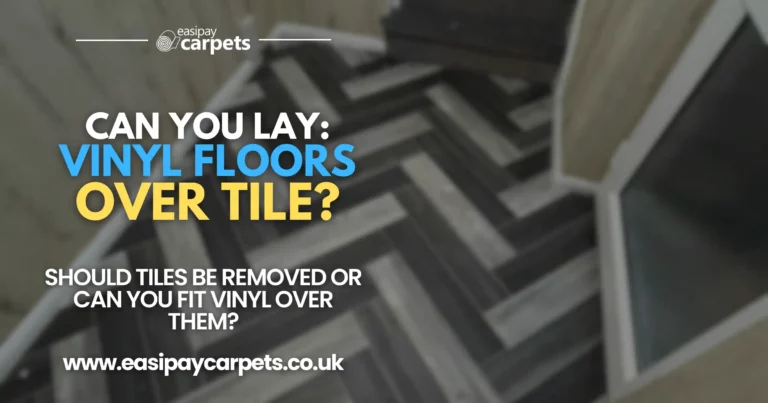

Can Vinyl Flooring Be Laid Over Tile?
Updating your floors can instantly transform a room’s look and feel. Vinyl flooring, known for its durability and wide range of styles, is a popular choice for many homeowners. But if your floors are currently tiled, you might wonder if you can skip the hassle of tile removal and lay vinyl directly over the existing surface. Here’s what you need to know about whether vinyl flooring can be installed over tile, the advantages and disadvantages, and the steps for a smooth installation.
Can Vinyl Flooring Be Installed Over Tile?
Yes, vinyl flooring can often be installed over tile, making it a convenient option for anyone looking to update their floors without tearing out old tile. However, successful installation depends on a few key factors, including the condition of the tile, the type of vinyl flooring you choose, and the level of preparation you’re willing to undertake.
Benefits of Installing Vinyl Flooring Over Tile
Laying vinyl flooring over tile offers several benefits, particularly if you’re aiming for a quick and cost-effective flooring update.
1. Saves Time and Effort
Removing tile is labour-intensive and can take several days to complete. By installing vinyl directly over the tile, you can save time, avoid heavy labour, and minimize the mess.
2. Cost-Effective
Eliminating tile removal saves on labour costs, making it an economical option. Plus, vinyl is generally more affordable than other flooring materials, providing a budget-friendly update.
3. Stylish and Versatile
Vinyl flooring comes in a wide array of styles, including options that mimic hardwood or stone, allowing you to achieve the look you want without extensive remodelling.
4. Additional Insulation and Soundproofing
Vinyl installed over tile can add a layer of insulation and help with soundproofing, making your floors warmer and quieter, especially if you choose a vinyl option with a built-in underlayment.
Potential Challenges to Consider
While laying vinyl over tile has its advantages, there are also some challenges and limitations to consider.
1. Uneven Tile Surfaces
If your existing tile floor is uneven or has grout lines that create grooves, these imperfections may show through the vinyl, causing visible bumps or dips. To achieve a smooth vinyl surface, you may need to level the tile with a patching compound or use a thicker underlayment.
2. Tile Height and Door Clearance
Adding a layer of vinyl over tile increases floor height, which may interfere with doors, trim, or thresholds. Measuring carefully and trimming any necessary areas beforehand can prevent these issues.
3. Potential Moisture Trapping
If moisture is present under the tile, it can get trapped between the layers and lead to mould growth or vinyl warping. To avoid this, ensure the tile is thoroughly dry, especially in moisture-prone areas like bathrooms or basements.
Steps for Installing Vinyl Flooring Over Tile
If you decide that laying vinyl over tile is the best choice for you, follow these steps to ensure a successful installation.
1. Check the Condition of the Tile
Inspect the tile for damage, such as cracks or loose tiles. Damaged tiles need to be repaired or removed, as they can compromise the vinyl’s stability and durability.
2. Level the Surface
To achieve a smooth finish, fill in grout lines and level any uneven tiles with a floor patching compound. Applying a self-levelling underlayment can also help achieve a flawless surface for vinyl installation.
3. Choose the Right Vinyl Flooring
Not all vinyl flooring is suitable for installation over tile. Luxury vinyl planks (LVP) or luxury vinyl tiles (LVT) with built-in underlayment work best, as they can cover minor imperfections and provide a more stable surface. Peel-and-stick vinyl is also an option, though it requires a very smooth surface to adhere properly.
4. Acclimate the Vinyl
Before installation, let the vinyl flooring acclimate to the room temperature for 48 hours. This will help prevent expansion or contraction after installation.
5. Install the Vinyl Flooring
Follow the manufacturer’s guidelines for your chosen vinyl flooring. For click-lock LVP or LVT, start from one corner and work your way across the room, snapping the pieces together. For peel-and-stick vinyl, ensure each tile is pressed firmly to prevent lifting.
Maintenance Tips for Vinyl Flooring Over Tile
Keeping vinyl flooring in good condition is simple with regular care. Here are some maintenance tips to keep your vinyl looking fresh:
- Sweep and Mop Regularly: Sweep frequently and use a damp mop with a mild, vinyl-safe cleaner to keep the floor clean.
- Avoid Abrasive Cleaners: Harsh chemicals or abrasive tools can damage vinyl. Stick to gentle cleaners and soft cloths.
- Prevent Moisture Accumulation: In moisture-prone areas, monitor the floor to ensure no moisture gets trapped, which could affect the vinyl or underlying tile.
Conclusion
Installing vinyl flooring over tile is a convenient and effective way to update your home’s look without the hassle of tile removal. By assessing the condition of the tile, preparing the surface, and selecting the right type of vinyl, you can achieve a smooth, durable finish that will last for years. While this approach saves time and money, taking care during installation and following recommended maintenance will help ensure your new floor remains stylish and resilient. Whether you’re updating a bathroom, kitchen, or living area, vinyl over tile can be a fantastic flooring solution.
Easipay Carpets can help you get brand new flooring without the high up-front cost – by simply letting you spread the cost of the flooring over time instead. There’s no interest on our plans so you aren’t spending a penny more than you would buying it outright and we include underlay, door trims, carpet grippers and laminate beading for free. Prices start from just £10 per week!
It starts with a free home appointment and quote, to get booked in at a time that suits you, tap the “Get Started” button below and fill out the contact form!
Still Got Questions? Here's 10 FAQs!
Uneven tile can cause issues. Use a patching compound to fill grout lines and create a smooth surface for the vinyl.
While underlayment isn’t always required, it can provide insulation and help smooth out minor imperfections in the tile.
Luxury vinyl plank (LVP) and luxury vinyl tile (LVT) with built-in underlayment are the most suitable options for installation over tile.
Yes, adding vinyl over tile will raise the floor height. Measure and adjust door frames or thresholds as needed.
Yes, but the tile surface must be completely smooth, as bumps can affect the adhesion and durability of peel-and-stick vinyl.
With proper care, vinyl can last 10-20 years, even over tile, depending on the product quality and installation.
Yes, but it’s crucial to ensure there’s no trapped moisture. Waterproof vinyl products work best in bathrooms.
Most types of vinyl can be removed with some effort, but peel-and-stick may leave adhesive residue, requiring more clean-up.
Without a smooth surface or underlayment, grout lines may show through. Levelling compound can help achieve a smooth finish.
Yes, certain vinyl types are compatible with radiant heat, but check with the manufacturer to ensure suitability.




